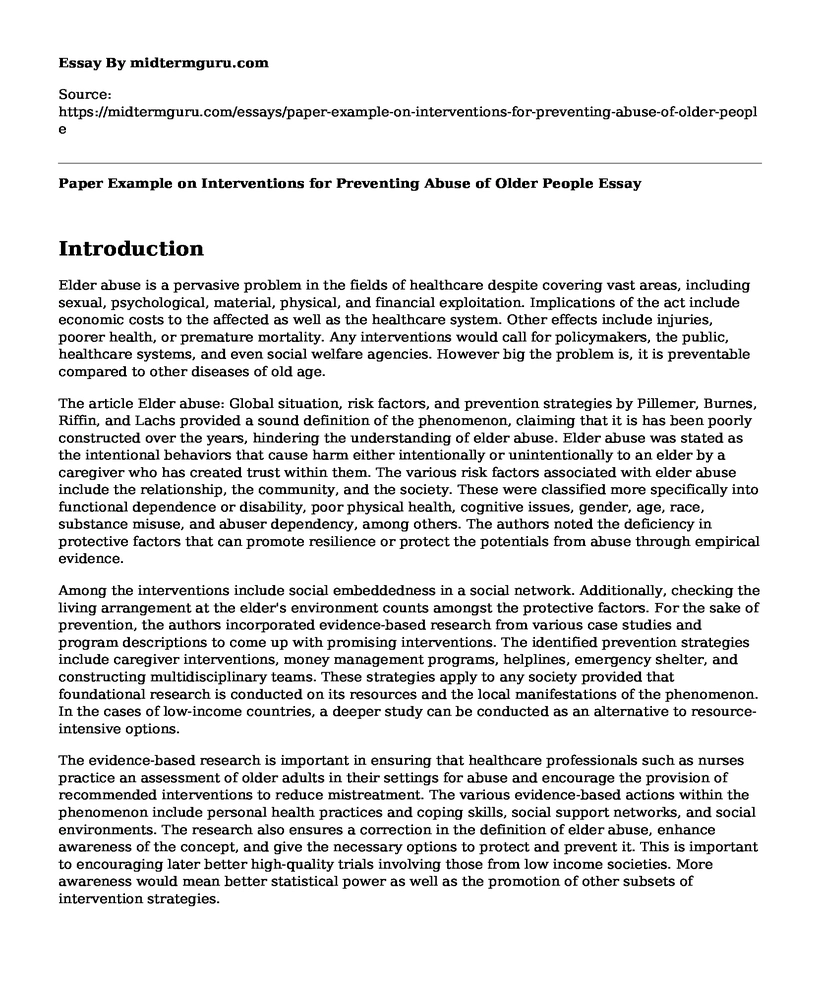Introduction
Elder abuse is a pervasive problem in the fields of healthcare despite covering vast areas, including sexual, psychological, material, physical, and financial exploitation. Implications of the act include economic costs to the affected as well as the healthcare system. Other effects include injuries, poorer health, or premature mortality. Any interventions would call for policymakers, the public, healthcare systems, and even social welfare agencies. However big the problem is, it is preventable compared to other diseases of old age.
The article Elder abuse: Global situation, risk factors, and prevention strategies by Pillemer, Burnes, Riffin, and Lachs provided a sound definition of the phenomenon, claiming that it is has been poorly constructed over the years, hindering the understanding of elder abuse. Elder abuse was stated as the intentional behaviors that cause harm either intentionally or unintentionally to an elder by a caregiver who has created trust within them. The various risk factors associated with elder abuse include the relationship, the community, and the society. These were classified more specifically into functional dependence or disability, poor physical health, cognitive issues, gender, age, race, substance misuse, and abuser dependency, among others. The authors noted the deficiency in protective factors that can promote resilience or protect the potentials from abuse through empirical evidence.
Among the interventions include social embeddedness in a social network. Additionally, checking the living arrangement at the elder's environment counts amongst the protective factors. For the sake of prevention, the authors incorporated evidence-based research from various case studies and program descriptions to come up with promising interventions. The identified prevention strategies include caregiver interventions, money management programs, helplines, emergency shelter, and constructing multidisciplinary teams. These strategies apply to any society provided that foundational research is conducted on its resources and the local manifestations of the phenomenon. In the cases of low-income countries, a deeper study can be conducted as an alternative to resource-intensive options.
The evidence-based research is important in ensuring that healthcare professionals such as nurses practice an assessment of older adults in their settings for abuse and encourage the provision of recommended interventions to reduce mistreatment. The various evidence-based actions within the phenomenon include personal health practices and coping skills, social support networks, and social environments. The research also ensures a correction in the definition of elder abuse, enhance awareness of the concept, and give the necessary options to protect and prevent it. This is important to encouraging later better high-quality trials involving those from low income societies. More awareness would mean better statistical power as well as the promotion of other subsets of intervention strategies.
Conclusion
Various medical practitioners, as well as community leaders, can also use the evidence-based research on existing interdisciplinary abuse teams to ensure that they are more sensitive in first-contact points such as emergency departments and primary care clinics (Sanchez Gonzalez et al. 2019). It is evident that if any protective or preventive measures can be promoted, it would start at those points. The research can also be used to instill knowledge to health personnel, allied professionals, and caregivers who do not understand what works to prevent elder abuse. Improving knowledge can lead to desirable changes in their behavior on the elderly (Baker, Francis, Hairi, Othman, & Choo, 2016). Caregivers, as well as other healthcare personnel, can change their negative attitudes towards the condition. Furthermore, with the stated protective and preventive measures on elderly victims can lead to lesser reporting of abuse. Therefore, the various recommended intervention measures can well mitigate the problem of elder maltreatment.
References
Baker, P. R., Francis, D. P., Hairi, N. N., Othman, S., & Choo, W. Y. (2016). Interventions for preventing abuse in the elderly. Cochrane Database of Systematic Reviews, (8).
Pillemer, K., Burnes, D., Riffin, C., & Lachs, M. S. (2016). Elder abuse: Global situation, risk factors, and prevention strategies. The Gerontologist, 56(Suppl_2), S194-S205.
Sanchez Gonzalez, M. L., McCord, C. E., Dopp, A. R., Tarlow, K. R., Dickey, N. J., McMaughan, D. K., & Elliott, T. R. (2019). Telemental health training and delivery in primary care: A case report of interdisciplinary treatment. Journal of clinical psychology, 75(2), 260-270.
Cite this page
Paper Example on Interventions for Preventing Abuse of Older People. (2022, Sep 10). Retrieved from https://midtermguru.com/essays/paper-example-on-interventions-for-preventing-abuse-of-older-people
If you are the original author of this essay and no longer wish to have it published on the midtermguru.com website, please click below to request its removal:
- Essay on Gender Wage Gap
- Article Critique Example: Inequality Has Been Going on Forever
- Essay Sample on Drug Addiction, Causes, and Effects
- Hannah Wilke: An Icon of Feminist Art Challenging Traditional Assumptions - Essay Sample
- Brie Files Discrimination Charge Against Employer: Legal Process Explained - Essay Sample
- Equal Employment: Overcoming Racism, Homelessness to Achieve Success - Essay Sample
- Trauma: A Distressing Mental Health Phenomenon - Essay Sample







